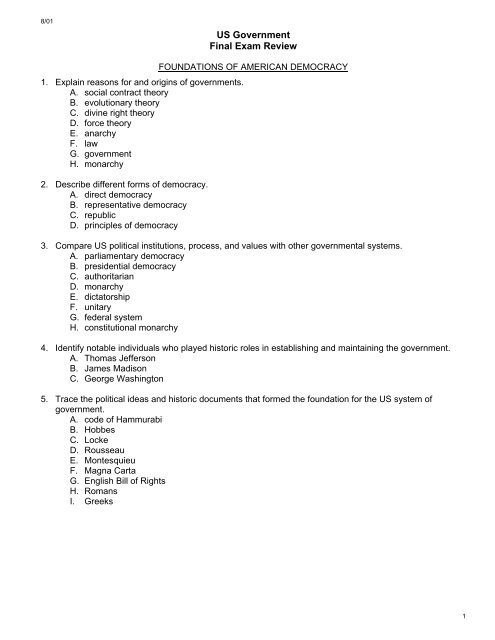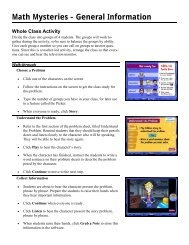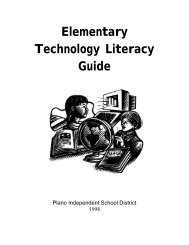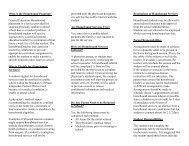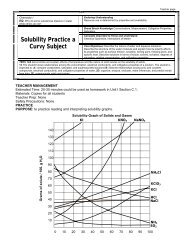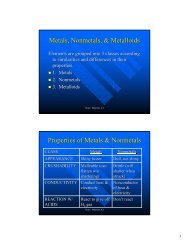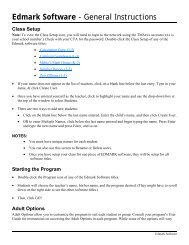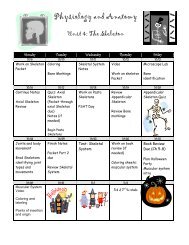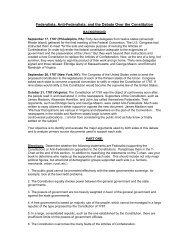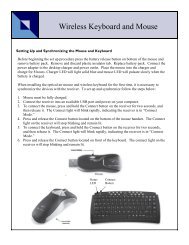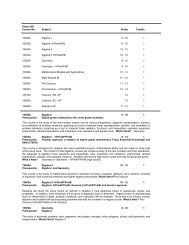US Government Final Exam Review
US Government Final Exam Review
US Government Final Exam Review
Create successful ePaper yourself
Turn your PDF publications into a flip-book with our unique Google optimized e-Paper software.
8/01<br />
<strong>US</strong> <strong>Government</strong><br />
<strong>Final</strong> <strong>Exam</strong> <strong>Review</strong><br />
1. Explain reasons for and origins of governments.<br />
A. social contract theory<br />
B. evolutionary theory<br />
C. divine right theory<br />
D. force theory<br />
E. anarchy<br />
F. law<br />
G. government<br />
H. monarchy<br />
2. Describe different forms of democracy.<br />
A. direct democracy<br />
B. representative democracy<br />
C. republic<br />
D. principles of democracy<br />
FOUNDATIONS OF AMERICAN DEMOCRACY<br />
3. Compare <strong>US</strong> political institutions, process, and values with other governmental systems.<br />
A. parliamentary democracy<br />
B. presidential democracy<br />
C. authoritarian<br />
D. monarchy<br />
E. dictatorship<br />
F. unitary<br />
G. federal system<br />
H. constitutional monarchy<br />
4. Identify notable individuals who played historic roles in establishing and maintaining the government.<br />
A. Thomas Jefferson<br />
B. James Madison<br />
C. George Washington<br />
5. Trace the political ideas and historic documents that formed the foundation for the <strong>US</strong> system of<br />
government.<br />
A. code of Hammurabi<br />
B. Hobbes<br />
C. Locke<br />
D. Rousseau<br />
E. Montesquieu<br />
F. Magna Carta<br />
G. English Bill of Rights<br />
H. Romans<br />
I. Greeks<br />
1
8/01<br />
6. Analyze the political, economic, and social reasons that led to the writing of:<br />
A. The Declaration of Independence<br />
1. colonial weaknesses<br />
B. <strong>US</strong> Constitution<br />
1. weaknesses of the Articles of Confederation<br />
2. Connecticut Compromise<br />
3. 3/5’s Compromise<br />
4. Commerce and Slave Trade Compromise<br />
C. Bill of Rights<br />
1. protection of individual rights and liberties<br />
D. Federalist Papers<br />
E. Anti-Federalist writings<br />
7. Compare and contrast the arguments for and against the ratification of the Constitution proposed by the<br />
Federalists and Anti-Federalists.<br />
A. lack of Bill of Rights<br />
B. strong Central <strong>Government</strong><br />
C. states rights<br />
8. Understand the basic principles and structure of the <strong>US</strong> Constitution.<br />
A. popular sovereignty<br />
B. separation of powers<br />
C. checks and balances<br />
D. limited government<br />
E. federalism<br />
F. judicial review<br />
G. preamble<br />
H. articles<br />
I. amendments<br />
9. Explain the process of constitutional change.<br />
A. formal amendment process<br />
B. informal changes<br />
10. Analyze the system of checks and balances.<br />
A. powers of each branch<br />
1. Legislative<br />
2. Executive<br />
3. Judicial<br />
B. how each branch checks the others<br />
1. L – J<br />
2. L – E<br />
3. E – L<br />
4. E – J<br />
5. J – L<br />
6. J – E<br />
11. Identify the division of powers between national and state governments.<br />
A. federalism<br />
B. delegated or expressed powers<br />
C. reserved powers<br />
D. concurrent powers<br />
E. denied powers<br />
12. Interpret the concept that the <strong>US</strong> has a “government of law, not of men”<br />
A. <strong>US</strong> Constitution<br />
2
8/01<br />
THE POLITICS OF DEMOCRACY: POLITICAL BEHAVIOR, POLITICAL PARTIES, AND ELECTIONS<br />
1. Trace the development of the two-party system in the <strong>US</strong>.<br />
A. Federalists<br />
B. Anti-Federalist<br />
C. Democrats<br />
D. Republicans<br />
2. Identify notable individuals who played historic roles in establishing political parties.<br />
A. Andrew Jackson<br />
B. Abraham Lincoln<br />
C. Alexander Hamilton<br />
D. Thomas Jefferson<br />
3. Analyze the role of minor political parties, media, and interest groups in the American political process.<br />
A. lobbying<br />
B. alternative issues and candidates<br />
4. Identify factors that influence an individual’s political attitudes and actions.<br />
A. family<br />
B. education<br />
C. socioeconomic position<br />
D. independent voter<br />
5. Identify categories that describe political attitudes.<br />
A. liberal<br />
B. conservative<br />
C. moderate<br />
D. radical<br />
E. reactionary<br />
F. political spectrum<br />
6. Analyze the functions of political parties in the <strong>US</strong> political system.<br />
A. define issues<br />
B. nominate candidates<br />
C. promote compromise<br />
7. Evaluate the involvement and participation of individuals in the <strong>US</strong> political process.<br />
A. political parties<br />
B. interest groups<br />
C. elections<br />
8. Explain the election process.<br />
A. caucus<br />
B. primary<br />
C. party platform<br />
D. national convention<br />
E. popular vote<br />
F. straight ticket<br />
G. split ticket<br />
H. electoral vote<br />
I. suffrage<br />
J. 15 th amendment<br />
K. 19 th amendment<br />
L. 24 th amendment<br />
M. 26 th amendment<br />
3
8/01<br />
THE FEDERAL LEGISLATIVE BRANCH<br />
1. Understand the structure and organization of Congress.<br />
A. Article I<br />
B. bicameral<br />
C. committee system<br />
D. seniority system<br />
E. Congressional leadership<br />
F. Constituents<br />
G. Redistricting<br />
H. Gerrymandering<br />
2. Evaluate the powers of Congress.<br />
A. expressed<br />
B. implied<br />
C. denied<br />
D. McCulloch v Maryland<br />
3. Understand the differences between the House of Representatives and the Senate.<br />
A. constitutional qualifications<br />
B. terms of office<br />
C. exclusive powers<br />
D. filibuster<br />
4. Trace the major steps by which a bill becomes a law.<br />
A. committee system<br />
B. role of interest groups<br />
C. power of the President<br />
5. Understand how the legislative branch interacts with the other two branches through its use of<br />
non-legislative powers.<br />
A. executive powers<br />
B. judicial powers<br />
4
8/01<br />
THE FEDERAL EXECUTIVE BRANCH<br />
1. Understand the structure and organization of the executive branch.<br />
A. Article II<br />
B. President<br />
C. Vice President<br />
D. cabinet<br />
E. bureaucracy<br />
F. Presidential succession<br />
2. Identify the qualifications the office of President and Vice President.<br />
A. Constitutional qualifications<br />
B. Informal qualifications<br />
C. Term of office – 22 nd amendment<br />
3. Analyze the roles and responsibilities of the President.<br />
A. Chief Executive<br />
B. Chief Legislator<br />
C. Chief of State<br />
D. Chief Diplomat<br />
E. Commander-in-Chief<br />
F. Chief of Party<br />
4. Identify the duties of the Vice President.<br />
A. President of the Senate<br />
B. 25 th Amendment<br />
5. Identify the various executive departments and functions of each.<br />
A. Cabinet level departments<br />
6. Understand how the executive branch interacts with the other two branches.<br />
A. judicial powers<br />
1. appointment<br />
2. pardon and reprieve<br />
B. legislative powers<br />
1. veto<br />
2. pocket veto<br />
5
8/01<br />
THE FEDERAL JUDICIAL BRANCH<br />
1. Understand the structure and organization of the judicial branch.<br />
A. Article III<br />
B. District Courts<br />
C. Courts of Appeal<br />
D. <strong>US</strong> Supreme Court<br />
E. jurisdiction<br />
2. Evaluate the selection process for the Supreme Court and other federal judges.<br />
A. constitutional qualifications<br />
B. informal qualifications<br />
C. term of office<br />
D. appointment and approval<br />
3. Describe the functions of the judicial branch.<br />
A. interpretation of constitutional law (judicial review)<br />
B. interpretation and application of statutory law<br />
4. Analyze the impact of <strong>US</strong> Supreme Court decisions on the American governmental system.<br />
A. Marbury v Madison<br />
B. McCulloch v Maryland<br />
C. Gibbons v Ogden<br />
D. Brown v Board of Education<br />
E. Roe v Wade<br />
F. judicial activism<br />
G. judicial restraint<br />
H. opinions of the court<br />
5. Describe the trial process.<br />
A. petit jury<br />
B. grand jury<br />
C. plaintiff<br />
D. defendant<br />
E. criminal case<br />
F. civil case<br />
G. due process<br />
6. Explain how cases reach the Supreme Court.<br />
A. writ of certiorari<br />
B. appellate jurisdiction<br />
C. original jurisdiction<br />
6
8/01<br />
THE RIGHTS OF ALL CITIZENS: CIVIL RIGHTS AND LIBERTY<br />
1. Identify the rights guaranteed by the Bill of Rights, 13 th , 14 th , and 15 th Amendments.<br />
A. civil rights and liberties<br />
B. equal protection clause<br />
C. due process clause(s)<br />
D. establishment clause<br />
E. free exercise clause<br />
2. Analyze the impact of Supreme Court decisions on civil rights and civil liberties.<br />
A. Miranda v Arizona<br />
B. Gideon v Wainwright<br />
C. Engel v Vitale<br />
D. Mapp v Ohio<br />
E. Brown v Board of Education<br />
F. Plessy v Ferguson<br />
G. Dred Scott v Sandford<br />
H. Furman v Georgia<br />
I. Bakke v Board of Regents of California<br />
3. Analyze the concept of due process and its role in the American system of civil rights.<br />
A. affirmative action<br />
B. “reverse” discrimination<br />
C. de jure and de facto segregation<br />
D. probable cause<br />
E. bill of attainder<br />
F. writ of habeas corpus<br />
G. ex post facto law<br />
STATE AND LOCAL GOVERNMENT<br />
1. Compare the structure of Texas (state and local) government to the national government.<br />
A. legislative branch<br />
B. executive branch<br />
C. judicial branch<br />
D. 10 th Amendment<br />
2. Compare taxing and spending functions of national, state, and local levels of government.<br />
A. property tax<br />
B. income tax<br />
C. sales tax<br />
D. federal grants<br />
E. expenditures<br />
7
8/01<br />
AMERICAN POLICY IN A CHANGING WORLD: <strong>US</strong> FOREIGN POLICY<br />
1. Trace and analyze the development of <strong>US</strong> foreign policy.<br />
A. isolationism<br />
B. Monroe Doctrine<br />
C. Truman Doctrine<br />
D. containment<br />
E. internationalism/involvement<br />
F. détente<br />
G. collective security<br />
H. deterrence<br />
I. Post Cold War challenges<br />
2. Identify the goals of American foreign policy.<br />
A. security of the <strong>US</strong><br />
B. human rights<br />
C. democracy<br />
D. economic prosperity<br />
3. Identify individuals and agencies that contribute to the formation of <strong>US</strong> foreign policy.<br />
A. President<br />
B. Congress<br />
C. State Department<br />
D. Defense Department<br />
E. United Nations<br />
OTHER NATIONS: COMPARATIVE GOVERNMENTS<br />
1. Compare and contrast <strong>US</strong> economic systems with other systems.<br />
A. command economy<br />
B. market economy<br />
C. mixed economy<br />
8


